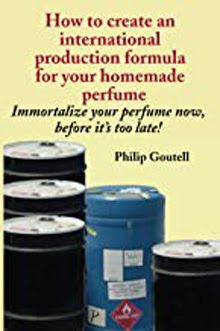A formula is what allows you to make more of what you liked the first time and avoid repeating mistakes.
A formula is a recipe but it is different than a cookbook recipe in one fundamental. A perfume formula can be used to project the COST of the formula. In perfume production, cost is important.
To write a formula from which costs can be projected, you need to reduce all ingredients in the formula to the same unit of measurement. For example, in a current project with four ingredients, one is sold by the gallon, one by the pound, and two are labeled in both grams and ounces. Each is priced by the container in which it is sold. This leaves us first with the decision one what unit to go with and then with the mathematics needed to reduce each ingredient to a common unit for both mixing and pricing.
Here I've gone for grams so I must now do the following calculations --
** For the two ingredients with contents listed in grams I have to calculate the PRICE PER GRAM for each. I'm making only a small batch of my product and one of the ingredients is very inexpensive so pricing in grams is appropriate. If I was producing larger quantity I probably would have gone with kilos as my weight/cost standard.
** For the ingredient sold by the pound, it was necessary to first convert pounds to grams and then do the math to calculate the price per gram. This was quite straight forward.
** Finally there was the task of converting gallons -- a liquid measure -- to grams, a measurement of weight. You do this by weighing out a sample of the liquid to get the gram weight for the volume you weighed. Then you calculate the grams per gallon. If your equipment allowed you to weigh a full gallon at one time you wouldn't need to make the second calculation. With gallons converted to grams, you can calculate the price of the liquid per gram.
** Once you have done your "price per gram" calculations, you can write your formula in grams AND project the materials cost for any quantity you chose to make. If your cost/gram for certain materials is reduced by bulk purchases you'll have to make the necessary adjustments.
** A cookbook recipe details not only the ingredients but the process of blending them. Perfume formulas don't usually require these extended instructions. My four-ingredient product involved flavoring (it was a beverage) and thus, as an aside, I had to write out how an herb was blended with spring water, the length of time the water was boiled, and the filtering out of the herbal residue. This was a bit like detailing the production process of a particular batch of an essential oil.
At the completion of the project, after a month or so of aging, the product will be filtered again to remove another residue. Then additional aging will take place.
The project itself involved making mead, an ancient, alcoholic beverage. The ingredients are honey and water. A bit of yeast thrown in gets the honey fermenting. The herb was used for additional flavoring (what will be my "secret" recipe.)
Note that the flavor and fragrance industries have long been one. Some prominent F&F houses got their start in the 19th century by developing flavorings for beer and candy. Fine fragrances came later.
The mead project was suggested by a beekeeper friend who converts some of his honey to mead. He also flavors his mead with various herbs and spices and, upon tasting a sample, I felt compelled to try making mead -- plus flavoring -- on my own.
My first small (400 ml) batch, fermenting and aging now, cost about $4.50 to produce. All ingredients were purchased at the local supermarket. Some say baker's yeast is a poor choice for making wine or mead but it is so easily available and inexpensive that it seemed like a good starting point.
Spring water, well water, or distilled water should be used. Tap water may contain chlorine and fluoride. These are undesirable for mead making.
I used a local, "all natural" honey. In other words, pure honey with no additives. And note, ALL honey is "organic." That's the only kind of honey bees know how to make!
Proportions? About one part honey to four parts water -- by volume -- not weight. So here we go "converting" our formula into another unit of measurement.
P.S. -- When you're making perfume or cologne, you always run into this issue. The fragrance oil and its ingredients are generally sold by weight -- kilos or pounds. But the alcohol, water, and fragrance oil you use to mix your finished perfume is measured in volume -- liters or gallons.
Learning how to make conversions is part of learning perfumery.
For conversion assistance you can use the conversion tool at http://www.bio-byte.com/amos/conversion.html
To write your formula AND get the cost for any quantity, use The Perfumer's Workbook.
A warning note: fermentation produces gas. If you're making a fermented beverage, don't seal the container. In a day or two the pressure from the gas will easily blow a cork off the top of a bottle. If you use a screw on closure, the pressure can break the bottle. I've been using a bit of plastic wrap with a small hole punched in it to let the gas out.
Tuesday, April 16, 2013
Subscribe to:
Post Comments (Atom)


No comments:
Post a Comment